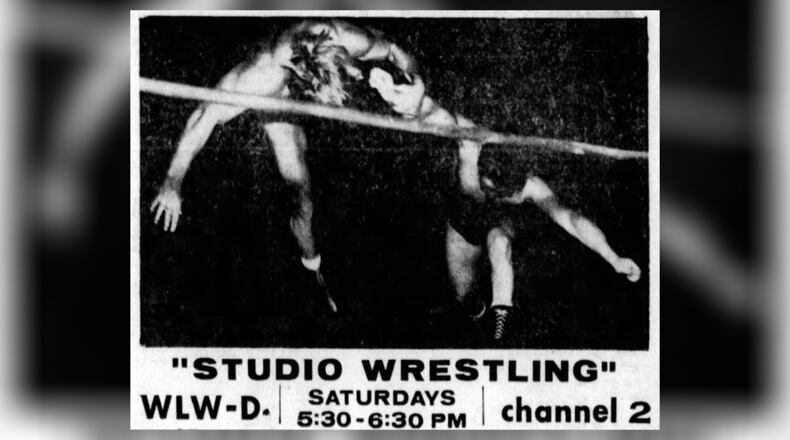The programs were filmed in those early days and were later distributed to 30 other television stations throughout the country.
Some of the stars were Chief Don Eagle, Antonio Rocca and “Nature Boy” Buddy Rogers.
Among those who once appeared in the Channel 2 studio audience were boxers Jack Dempsey and Max Baer, and movie star Gloria Swanson, who was a big wrestling fan.
Television watchers who remember those days will never forget the name Bouncing Beulah. She was an extraordinary wrestling fan who, because of her antics and energy, became more famous than many of the wrestlers.
Representatives of Life and Newsweek magazines came to Dayton to do stories and take photos to tell the nation about studio wrestling here.
Neal Van Ells
Announcer Neal Van Ells married Phyllis McGuire of the famous Miamisburg McGuire Sisters. A viral story developed when he once was bequeathed $12,000 in the will of a female wrestling fan who liked him.
Van Ells was named beneficiary in a $6,000 double indemnity policy on the life of Susie Robison, 68, who was killed in an auto-truck crash.
The woman only knew him as the announcer on the station’s Saturday night studio wrestling show.
“You could have knocked me over when I returned to town Monday from New York, and received a call about the policy from Leland Electric company,” he said at the time.
Van Ells, who had been visiting his wife, said he put the telephone down a minute to catch his breath.
“I get kidded a lot in this business and I thought someone was trying to run one on me,” he said.
It didn’t take much checking from his attorney to prove the telephone call was true, and that Robison, a widow since 1948, was a “great wrestling fan.”
Omar Williams
Omar Williams started as a sportscaster with Channel 2 when he took over the Studio Wrestling matches from Van Ells back in the mid-1950s.
“I had never seen a wrestling match before I started,” he once said.
In those days, Studio Wrestling was one of the hottest shows on the local air.
“Looking back, I realize how phony some of it was, but when it was happening I never thought much about it, because I was having too much fun,” Williams said in a 1986 Dayton Daily News interview.
“We had seats for 250, but we squeezed 400 in there,” Williams said. “The fire marshals always screamed their heads off, then they’d stick around to watch the matches.”
Counted out
Studio Wrestling aired from 1950-55, before returning from 1959-62.
In 1955 the headline was “STUDIO MAT SHOWS HERE ON WAY OUT.”
Robert Dunville, president of the Crosley Broadcasting corporation, announced the end of the TV mat shows, citing waning interest.
Near the end there were two shows, a Saturday afternoon show from Columbus and an evening show from Dayton.
In 1959, Studio Wrestling attempted a comeback that lasted 3 years.
In 1962, in the interest of “total family” entertainment, WLW-D announced that Studio Wrestling was once again to be taken off air.
Another comeback — in color
In 1967, Studio Wrestling in Dayton returned to the air, this time on Channel 16.
For the first time, it was aired in color.
For the first episode, The Sheik, who was one of the top badmen in the wrestling world, was to meet Flying Fred Curry in the main event.
Ernie Roth was the ringside commentator, and there were just 40 people in the live audience.
By 1972, wrestling events had moved to Hara Arena, where they were taped and shown later on Channel 22, WKEF-TV.
About the Author








